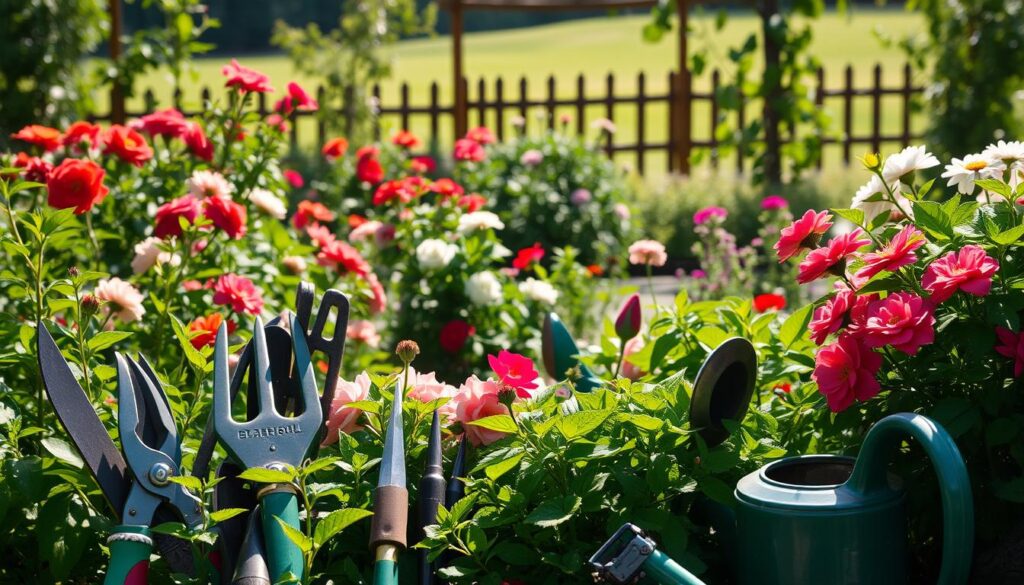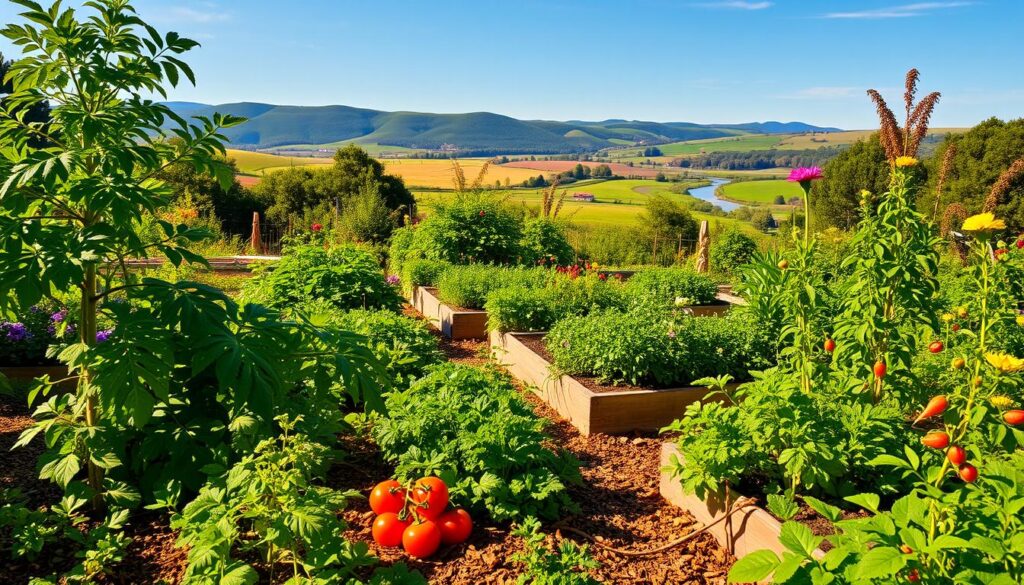Ultimate Gardening Tips for Lush Gardens

About the Game
Creating lush gardens takes knowledge, creativity, and patience. No matter the size of your space, these tips will help. They make vibrant landscapes that bring joy.
This guide offers key strategies for choosing plants, caring for your garden, and designing it. With dedication and the right steps, you can make any space flourish.
Understanding the Basics of Gardening
Gardening is very rewarding but you need to know a few things first. You must understand your local climate to pick the right plants. Knowing this is the first step in gardening well.
Anúncios
Familiarize Yourself with Local Climate
Where you live affects what plants you can grow and how you garden. You need to know the temperatures, rain, and seasons in your area. This helps you know when to plant and when to harvest. It’s also key to know your hardiness zone to pick winter-surviving plants.
Know Your Soil Type
Healthy plants start with the right soil. Soil can be sandy, clay, or loamy, each with its pros and cons. Testing soil tells you its pH and what nutrients it has. This lets you fix the soil to grow plants better.
Anúncios
Sunlight Conditions
Knowing how much sun your garden gets is crucial. Plants need different amounts of light, from full sun to shade. Check how much light your garden spots get daily. This helps you choose the right plants for each spot, making your garden both beautiful and healthy.

Preparing Your Garden Soil
Healthy soil is key to a great garden. It influences how well plants grow. By understanding soil health, gardeners can make sure their garden thrives. This starts with checking the soil, including tests for pH levels and nutrients.
Importance of Soil Health
Soil health is vital for plants’ life. Good soil provides nutrients and retains air and water well. When the soil is healthy, plants can fight diseases and pests better, leading to more fruits and veggies.
Testing Soil pH and Fertility
It’s important to test your soil. This tells you if your soil has nutrient problems or if its pH is off. Testing helps gardeners know how to improve their soil for better plant growth.
Amending Soil with Compost and Organic Matter
Adding compost and organic matter helps soil health a lot. These add nutrients, help with drainage, and improve the soil’s structure. Mixing in compost creates a good environment for helpful microbes, which help plants grow.
Choosing the Right Plants for Your Space
Choosing the right plants is key for a beautiful garden. Knowing how much sunlight and water they need helps them thrive. Adding different kinds of plants not only looks good but also brings in important pollinators.
Factors to Consider: Sunlight and Water Needs
Every plant needs specific amounts of sunlight and water. Keep this in mind to make sure they grow well:
- Figure out which parts of your garden get full sun, partial shade, or full shade.
- Make sure the plants you pick can be watered as much as they need in your garden.
- For plants that like it dry, use soil that drains well. For thirsty plants, keep the soil moist.
Diversity in Plant Selection
Choosing a variety of plants makes your garden lively and healthy. Include these in your garden:
- Native plants do well locally and help wildlife.
- Flowers draw in pollinators, making your garden more productive and beautiful.
- Plants with leaves add interest and structure all year.
Optimal Planting Depth and Spacing
Know how deep and far apart to plant each species. This helps roots grow and avoids overcrowding:
- Follow depth recommendations for healthy plant growth.
- Space plants so they all get enough sun, nutrients, and water.
- Think about how big plants will get to avoid them being too close.
Effective Watering Techniques
Getting the watering right is key to a thriving garden. It’s important to find the sweet spot between giving your plants enough water and saving water. We’ll look at ways to make sure your plants are well-watered without wasting a drop.
Deep and Infrequent Watering
Deep and infrequent watering helps plants grow strong roots. This way, they can better withstand droughts by reaching deeper moisture in the soil. Shallow watering often only leads to weak roots.
This increases plant stress during dry periods. Try to water thoroughly but less often. This keeps the soil moist just right.
Water Delivery Methods: Drip Irrigation and Soaker Hoses
Choosing the right way to water is crucial for efficient plant care. Drip irrigation directs water straight to the roots slowly. This cuts down on evaporation and wasted water. Soaker hoses are another great option. They release water slowly across their length.
Both methods help avoid wet leaves, which can cause disease. They’re smart choices for keeping plants healthy and hydrated.
Garden Maintenance Strategies
Keeping a garden looking great is key. It needs regular weeding, pruning, and mulching. These tasks boost your garden’s health and look. Plus, they make your outdoor space better for chilling and fun.
Regular Weeding and Pruning
Weeding often is super important. It lets your plants get all the water and nutrients they need. With no weeds, you also get fewer garden pests. Pruning keeps air moving between plants and encourages them to grow strong.
Mulching Benefits
Mulch is a garden’s best friend. It keeps weeds away and helps soil keep moisture. Over time, it breaks down and feeds your plants. Using mulch makes gardening easier and is good for the earth.
Designing a Lush Garden Layout
Creating a welcoming garden layout means carefully placing elements to boost both beauty and function. A top-notch garden layout has clear focal points that grab and guide the viewer’s eye through the area. Such focal points could be unique sculptures, bright flower beds, or well-placed trees.
When you mix sizes, shapes, and colors, you make your garden stand out with stunning contrasts. This adds depth and excitement to your garden, making it more lively and inviting.
Creating Focal Points in Your Garden
Focal points act as anchors, pulling the eye toward special spots in the garden. You can add various elements, such as:
- Eye-catching flowers that bloom in different seasons
- Artistic garden ornaments or water features
- Distinctive plant varieties or groupings
Using these features adds interest and enhances your garden’s look. Placing these points smartly makes people want to explore and admire your garden more.
Using Color and Texture
Color and texture have a big impact on how your garden feels. Picking colors that go well together makes your garden look good and feel harmonious. You might think about:
- Using contrasting colors to highlight certain plants
- Choosing plants with different leaf shapes and textures for depth
- Layering plants for a cool visual effect
If you carefully use color contrasts and mix textures, your garden will look and feel lively and beautiful.
Embracing Sustainable Gardening Practices
Sustainable gardening helps protect our environment and boosts biodiversity. By using organic fertilizers and natural pest control, gardeners help create a healthier planet. This approach supports both plants and the broader ecosystem of living creatures, like helpful insects and pollinators.
Organic Fertilizers and Pest Control
Organic fertilizers improve soil and plant health without synthetic chemicals’ harsh impacts. These natural choices make gardens flourish with much-needed nutrients. Alongside organic fertilizers, non-chemical pest control keeps the ecosystem intact. Practices like planting certain plants together and bringing in beneficial bugs help control pests naturally, keeping everything in balance.
Supporting Local Wildlife through Native Plants
Adding native plants to your garden helps local wildlife thrive. They offer homes and food for birds, bees, and pollinators, balancing your garden’s ecology. This also helps gardens fight pests and diseases. Native plants are perfect for sustainable gardening, needing less water and adjusting well to local climates.
Documenting Your Gardening Journey
Documenting your gardening adventures boosts your skill and joy. A garden journal is a great way to note vital facts. These include plant development, weather struggles, and achievements. Checking your records helps you learn and make smarter choices later.
Keeping a Garden Journal
A garden journal lets you jot down every little detail. Track when you plant, the weather, bug problems, and soil changes. This habit helps figure out what works and what doesn’t. A well-kept journal is key to becoming a better gardener.
Taking Photos to Track Progress
Photos are also important in recording your garden’s journey. Snap shots often to capture your garden’s evolution and the growth of plants. These photos track your progress and let you reflect on your methods. By watching how plants grow, you learn which ones do best in your area.
Conclusion
Gardening is more than just a hobby; it’s a journey of exploration and growth. Every step, from knowing the climate to picking the right plants, helps you succeed. This guide gives you the tips you need to get better at gardening, creating a space that’s both beautiful and sustainable.
In your gardening journey, remember the importance of patience and creativity. Each garden is a unique work of art that shows your hard work. By continually learning, you can overcome any challenge and celebrate your success, making your garden a peaceful place.
Whether you’re starting out or already have a green thumb, making your garden flourish is an ongoing process. Your dedication to caring for plants and beautifying your space does wonders for your home and the environment. It leaves a lasting mark of garden harmony.
FAQ
What is the importance of understanding my local climate for gardening?
How can I improve soil health in my garden?
What factors should I consider when selecting plants for my garden?
How often should I water my garden?
What regular maintenance tasks should I perform to keep my garden healthy?
How can I create interest in my garden design?
What are sustainable gardening practices?
Why is it beneficial to keep a garden journal?
Game Details
No
No